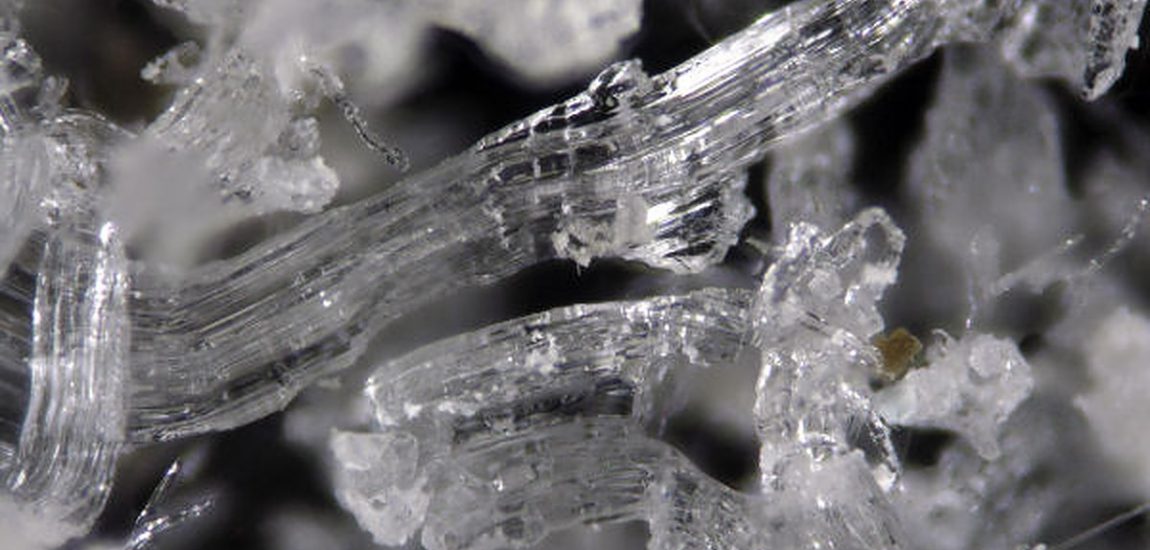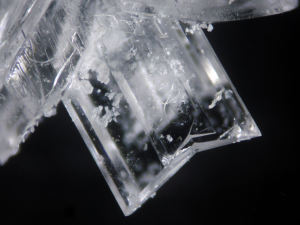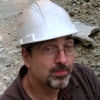
From the winners of the EAG Photo Contest 2014
César Menor-Salván and Olivier Pourret are the winners of the EAG Photo Contest 2014 and we have asked them tell us more about their photos and their passion…
“Destructive Beauty”: winning photo of the theme “The changing world: geochemistry in action”
The picture shows crystals of neoformed Epsomite (magnesium sulfate heptahydrate) in a wall of my own house, affected by “sulfate attack”. The sulfate attack is the alteration process of building materials by sulfate-rich rising damp, usually by groundwater infiltration. When I closely examined the strong damage that suffered the wall, I observed glittering crystals in the water front that was moving upward by capillarity. As my passions are the photomicrography and the mineralogy, I saw it as an opportunity to understand how the groundwater destroy the building materials. I thought that I had caught out in the act the process of formation of hydrated secondary phases by weathering of previous materials. Geochemistry in action in my own walls! The glittering crystals saw promising, and, indeed, under the stereomicroscope showed the beautiful landscape that I tried to capture in the micrography.
As expected, the Raman spectrum of the crystals shown in the photography, confirmed it as Epsomite. The magnesium sulfate reaches saturation in the ascending water and forms efflorescences and salty deposits (salitre in Spanish). In this case, the low temperature and stability of conditions favored the crystal growth. The crystallization of Epsomite, a highly hydrated mineral, provokes internal pressure in the materials, swelling, fractures and paint peeling. The Epsomite stability zone is very limited and, with decreasing relative humidity, it dehydrates forming Pentahydrite (also identified by Raman spectroscopy), that forms white, dull pseudomorphs after Epsomite. Further dehydration converts the crystals in a white powder. The dehydration leads to shrinking and collapse of the building material.
The saturated sulfate solutions react with materials as concrete, forming other secondary phases, as the thin acicular crystals in the lower right corner of the picture, identified as Thaumasite. The reaction between sulfate-rich infiltrating solutions and the calcium silicates and aluminates in the concrete, lead to the formation of Ettringite and Thaumasite, provoking flacking and softening of the concrete and consequent collapse of the structures.
Despite of the losses associated with the destruction of building materials, I could not resist the temptation to show the inner beauty of the process: beauty contained in the transformation of materials and formation of new minerals, and the aesthetic impression of the crystals. This is the beauty of Nature, that remind us that all of our creations, civilizations and cultures, futile attempts to transcend, are weak, impermanent and subject to the laws of Geochemistry, that is, the law of constant flow and change. This beauty (conceptual and aesthetic), sometimes hidden to our naked eyes, but always present in Nature and our laboratories, drives my interest in the photomicrography. My routine equipment consist in a Nikon Coolpix camera attached to the phototube of a Zeiss Discovery V8 microscope. The picture is the result of layer composition of 10 frames. Field of view is 2 mm.
“Twin”: winning photo of the theme "Geochemistry in a test tube"

The photography shows a swallowtail twin of Gypsum. This twin was grown in silica gel by slow diffusion of calcium and sulfate ions. Modelling the crystal growth of low water soluble salts (as some mineral phases) in gel is very easy. For the specimen in the photography, I used a U shaped tube filled with silica gel, formed by slow acidification of a sodium silicate solution. One side is filled with calcium ion solution (as calcium chloride) and the other side with sulfate anion solution (as sodium sulfate). After a few days, layers of crystals, forming rings and zones with several crystal sizes, ranging from submilimetre to 0.5 cm, were formed.
This method allows seeing how physical or chemical variables, as temperature, concentration and impurities, govern the preference for different crystal habits or the formation of polymorphs. Also, by its simplicity and beauty, it could be a valuable didactic tool: the students could see how minerals as gypsum, calcite, aragonite, apatites and more, could be formed in different conditions. The equipment used for the photomicrography was a Nikon camera attached to a Zeiss
About César Menor-Salván
After his PhD in Chemistry, César Menor-Salván began to research in the Center of Astrobiology (CAB, Madrid, Spain), working in the fields of Chemical Evolution, the Geochemistry and Mineralogy of the origin of biochemical systems and the role of ecosystems in the formation and transformation of mineral deposits. Now, due to the financial crisis of Science in Spain, he maintains his scientific interests as an independent researcher. Apart from Astrobiology, his passions are the Microscopy and Mineralogy and he tries to share his fascination for the micro-world through photomicrography.
“Bacteria vs mineral”: winning photo of the theme “Geochemistry and life”
In the days following the Goldschmidt Conference in Moscow (Idaho) May 2005, I attended an unofficial post meeting 10 day trip to visit the spectacular geothermal features at Yellowstone National Park in Wyoming. Among the geologic, geothermal and volcanic features of Yellowstone National Park, and aside wildlife (I have also taken some incredible photographs from bisons), I was amazed by hot springs and associated thermophillic biota as on this photograph of Morning Glory Pool north to Yellowstone’s most famous feature-Old Faithful Geyser. Orange, and yellow algae-like bacteria prosper in the cooler water, gradually turning the colorful aqua-blue into a greenish brown. Bacteria bloom when the hot spring’s temperature drops.

About Olivier Pourret

Olivier Pourret received his PhD in Earth Sciences in 2006 from Université de Rennes 1 (France) and is now an associate professor of geochemistry at LaSalle Beauvais (France). His research interests include trace metal fractionation and particularly Rare Earth Elements (REE) in low-temperature aqueous systems, a better understanding of trace metal cycles in natural waters, and an improved knowledge of trace metals transport from rivers to ocean.
